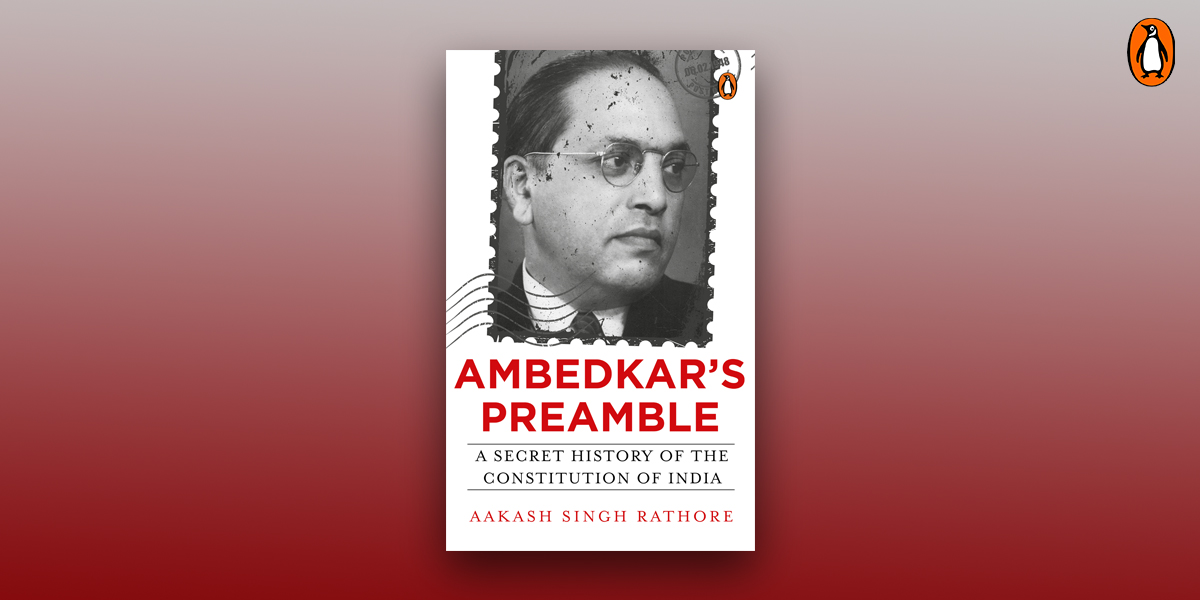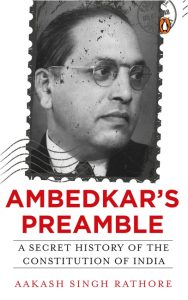
Although Dr Ambedkar is universally regarded as the chief architect of the Constitution, the specifics of his role as chairman of the Drafting Committee are not widely discussed. Totally neglected is his almost single-handed authorship of the Constitution’s Preamble, which is frequently and mistakenly attributed to B.N. Rau rather than to Ambedkar.
With Ambedkar’s Preamble, Aakash Singh Rathore sets out to establish how and why the Preamble to the Constitution of India is essentially an Ambedkarite preamble. It is clear that its central concepts come from Ambedkar’s writings and speeches. In doing so, the book spotlights fundamental facts about modern Indian history – which makes this a highly relevant read today.
The excerpt below gives us a glimpse into Ambedkar’s role within the Drafting Committee:
Justice: The Story of B.R. Ambedkar
On 21 February 1948, Dr Ambedkar, in his capacity as chairman of the Drafting Committee, was ready to submit the first draft Constitution that had been prepared over the forty-two sittings. The meetings began on 27 October 1947, the first since the one on 30 August when Dr Ambedkar had been elected chairman. He sent it to the president of the Constituent Assembly, Rajendra Prasad, who had it widely published on 26 February, so that interested members of the public could consider it. The draft was also sent to all members of the Constituent Assembly, asking them to submit their views by 22 March 1948. A number of amendments were suggested, some specific to the Preamble, but not one of them was about the concept of justice.

The Drafting Committee reconvened on 23, 24 and 27 March 1948 to evaluate the many comments and suggested amendments they had received. Since the committee had introduced both phraseology and substance that seemed to depart from the Constituent Assembly’s earlier decisions, president Prasad decided to assemble a high-powered Special Committee to look carefully into the matters in question—the draft Constitution, the numerous amendments suggested, the Drafting Committee’s opinions on them, and so on. The Special Committee was chaired by Jawaharlal Nehru and consisted of the who’s who of the Constituent Assembly. It included members of the Drafting Committee, of course, but also principal members of the Union Constitution Committee, as well as the Provincial Constitution Committee. Meeting on 10 and 11 April 1948, many of the names who subsequently enlivened the CAD included Bhogaraju Pattabhi Sitaramayya, Khushal Talaksi Shah, Jivatram Bhagwandas Kripalani, Kanaiyalal Maneklal Munshi, Thakur Das Bhargava, and, of course, B.R. Ambedkar, who never missed a Drafting Committee or related meeting. Also present was Naziruddin Ahmad, whose suspicion that the Drafting Committee was prone to taking ‘secret’ and unilateral decisions was now beginning to crystalize.
The minutes of the Special Committee meeting on 10 April 1948 were unusually curious. They began: The committee considered the matters referred to in the letter of the Chairman of the Drafting Committee to the President of the Constituent Assembly of India, dated the 21st February 1948. Preamble: The consideration of the amendments to the Preamble was held over and it was decided that the final settlement of the Preamble should be left to the decision of the Constituent Assembly.
This was unusual because the entire reason behind assembling the Special Committee was to try and scrutinize the changes that the Drafting Committee had introduced to the draft Constitution, one of the most crucial being the unanimously adopted Objectives Resolution. As we shall soon discover, one of the earliest points in Dr Ambedkar’s letter to the president of the Constituent Assembly was to do with the unilateral changes introduced by the Drafting Committee into the Preamble. It appears that Nehru was true to his word and that he ensured—rather to the displeasure of Naziruddin Ahmad—that the Drafting Committee was given the latitude to adapt the Objectives Resolution to the changing times.
A narrative like Ambedkar’s Preamble is crucial for our times today – especially in helping us develop new and important insights into the most important document for our country.









